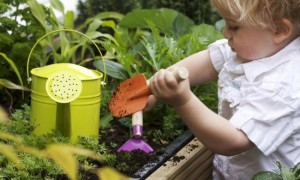Garden activities for kids, Uncategorized
10 Tips To Get Children Involved In The Garden

1 Have Fun
Without doubt the most important tip of all! As a child when I visited my grandparents, I always received the fun tasks in their extensive vegie patch. I was never asked to weed, but always ready to help out with harvesting, planting or watering on a hot day! Let the kids do the fun activities and do the mundane jobs yourself.
2 Give Children Their Own Space To Garden.
Let your kids have ownership of their own garden bed, to grow their own plants and to decorate it how they want to. Start with easy to grow vegies, flowers or herbs. All of the plants in our Vegie, Flower and Herb Patch Kits have been specially chosen to be easy and quick to grow.
3 Have Tools That Are Made For Children
Having size appropriate tools can make all the difference. Gloves that fit snugly are a must, as are hand tools specifically designed for children. A large watering can is going to be too heavy for a child to lift, but a smaller one or a Bottle Top Waterer will be just perfect.
4 Start Small
Whilst we would all love to have magnificent blooming gardens that flow on for acres, we need to be realistic when gardening with kids. Start with a small garden bed, or plant some strawberries or tomatoes in a pot or two. Probably, one of the easiest ways to start growing is to grow vegetable tops on a saucer of water; Carrots, leeks, turnips, celery and bok choy will all grow leaves from the stem that is usually thrown away or composted.
5 Plant The Right Plants For The Season And Climate Zone
Kids will quickly loose interest if seeds don’t germinate or plants die, so make sure that the plants you grow are appropriate. Growing pineapples or bananas in Victoria or Tasmania will probably never work, likewise, growing broccoli or cauliflower during the wet season in Northern Australia will be a disaster! Research online or use our Grow Guide to ensure your kids have every chance of gardening success.
6 Aim For Some Quick Results
Kids will respond better to plants that grow and/or germinate quickly. Try planting some cress or radish seeds, both these seeds with germinate within a day or two. And just like my kids, I always get excited to see my new “babies”! Making a Cress Egg Head can be a fun and nutritious activity for children.
7 Get Arty
Gardening isn’t always about growing plants. Children will love to make a scarecrow, a bird feeder or even paint their own rocks to use as plant labels garden art. Older children can write the names of plants on the rocks, whilst younger kids can plant the colour of the flower, or simply do their own thing!
8 Reuse, Repurpose, Recycle!
“Junk Gardening” can look absolutely fantastic and this a bit of creativity, lots of items that we throw away can be used in the garden, and it teaches are children an important lesson about sustainably. We recently made a herb garden from an old kettle BBQ. Another great idea for children is to make mini gardens from used tin cans. My children have painted old surfboards and a worn out rotary clothes line, all used to brighten up the garden. Almost another can be used, one of my daughters came home from school recently with sweet peas planted in an old pencil case! Be creative, the kids will love it!
9 Create Some Wild Areas
Children love seeing wildlife in their garden. Try creating a birdfeeder, a bird bath or even a lizard lounge. Grow some plants that attract butterflies and birds.
10 Be Prepared For Some Loses
When planting seeds, seedlings or plants with children, I usually use at least twice as many as are required. As all gardeners know, sometimes things don’t go to plan and plants die or seeds don’t germinate. By doubling the required number you will reduce the chance of a complete flop, so the children won’t loose interest. And if garden plan A doesn’t work, remember there are 25 other letters in the alphabet.
I hope these ideas will give you some inspiration to help your kids love gardening and growing their own food. For even more ideas for involving children in the garden check out this gardening with children blog by Garden Loka.
Happy Gardening
Erica

